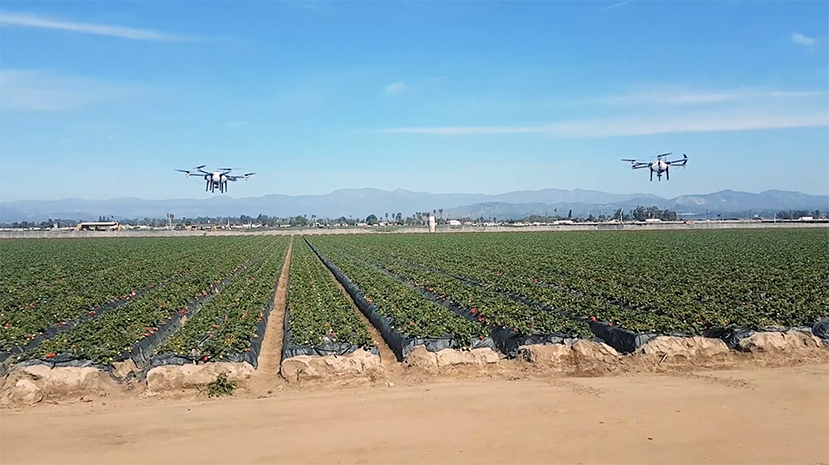Skyx is an agricultural-robotics technology company enabling a modular swarm of autonomous drones for spraying. It develops proprietary tools and algorithms for optimal homogeneous coverage of complex space, real-time swarm operation, and coverage of “hot-spots”.
Skyx develops proprietary tools and algorithms for optimal homogeneous coverage of complex space (including static and dynamic obstacles), real-time swarm operation, and coverage of “hot-spots”: unlimited number and shape of spots. We compile four orthogonal layers: the terrain + crops + pesticides + the available machinery into an optimized mission planning, auto-execution, and real-time control of each robot. Each robot can have different performance and accuracy levels and therefore the optimized solution fits for small, medium, or large farmlands. SKYX solution is for spraying applicators, and not for growers.
We develop two main products:
Uniform Coverage (UC): The area treated is sprayed homogeneously.
Spots Coverage (SC): The area is scanned from air (UV+IR+Image recognition) to detect affected areas (spots). The treatment is applied specifically in these spots.
SKYX enables precise agri-spraying by modular swarm of autonomous robots:
50 cms accuracy
24/7 on-demand availability
50% Cost reduction
Hot-spots coverage
Safety for workers
Less chemicals: cost reduction, more sustainable, higher product quality
How it works: SKYX customer (spraying provider) drives to the farmland to do their work. Typical equipment in the truck includes the robots (drones), the required pesticides that the growers (their References/Customers) selected and purchased, a few batteries, and spare parts.
Before driving to the farmland, SKYX mission planning already calculated the optimized starting location and the exact path and number of hops that each robot will perform, so the spraying provider already knows what exactly will be done by each robot (and he can also simulate more robots, agriculture constraints, etc.). Static obstacles and details about the farmland were already loaded in the software. Upon arrival to the farmland, a quick single-drone flight detects unexpected obstacles, and if needed an updated path is calculated by the software in milliseconds. The spraying provider assembles the swarm, (each robot is loaded with pesticides, batteries, propellers, cameras, and sensors) and according to the mission planning “go” button is pushed and activates the autonomous spraying swarm.
There is no need to fly/drive/control the entire operation. While the swarm is spraying, the operator monitors the progress and can decide to “abort” the mission. The swarm corrects in real-time glitches and can recalculate new segments (alerts are given to the operator). The only manual work the operator is doing is recharging batteries and tanks of pesticides between the multiple hops. At the end of the mission, detailed reporting is given for grower/customer pricing, maintenance of the fleet, and regulatory reporting.
Due to the expected population growth from 7 billion to 9 billion by 2050, the EU's Common Agricultural Policy noted that world food production needs to double by then and at the same time needs to institute 'greener' farming practices. Given there is not likely to be additional land available to meet these needs, higher yield influenced by precision agriculture will be essential. Drones, as part of overall autonomous robotics, are called to provide revolutionary forms of farming.
Spraying agricultural crops with pesticides and other materials is a common practice in order to protect the crops from harmful pests and diseases. 99% of global farmlands still use intensive human-driven spraying of chemicals: by flying airplanes, driving tractors, or manually with backpacks. Current practices lead to inefficiencies as Very high costs of operation, hand-workers present availability problems, and spraying aircraft can mostly be flown during the day and in good weather (for pilots' safety). Airplanes do not fly with obstacles or need to be high above the ground to avoid possible obstacles, thus the spraying accuracy cannot be guaranteed, leading to inadequate coverage (poor crop protection).
In addition, tractors are expensive to transport, working with pesticides is hazardous for people and the environment. The opportunity lies in developing technologies that allow increasing production, sustainability and safety, reducing costs and ensuring total and absolute crop protection to/against infections and diseases.
Drones have demonstrated to be a reliable solution for spraying fields and several brands manufacture and commercialize them. But it takes too long to spray a single field with just one drone. What none of these brands provide is the ability to autonomously control several drones at the same time, all of them cooperating in the spray mission.
